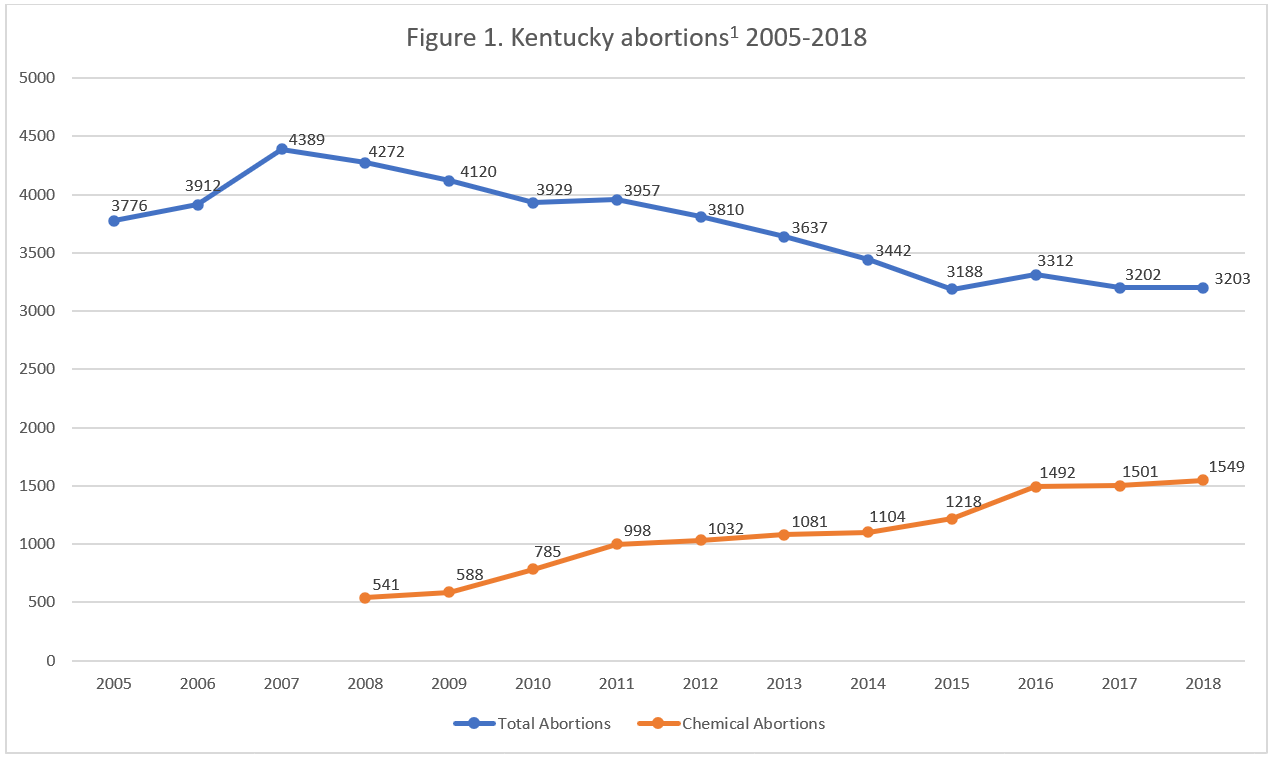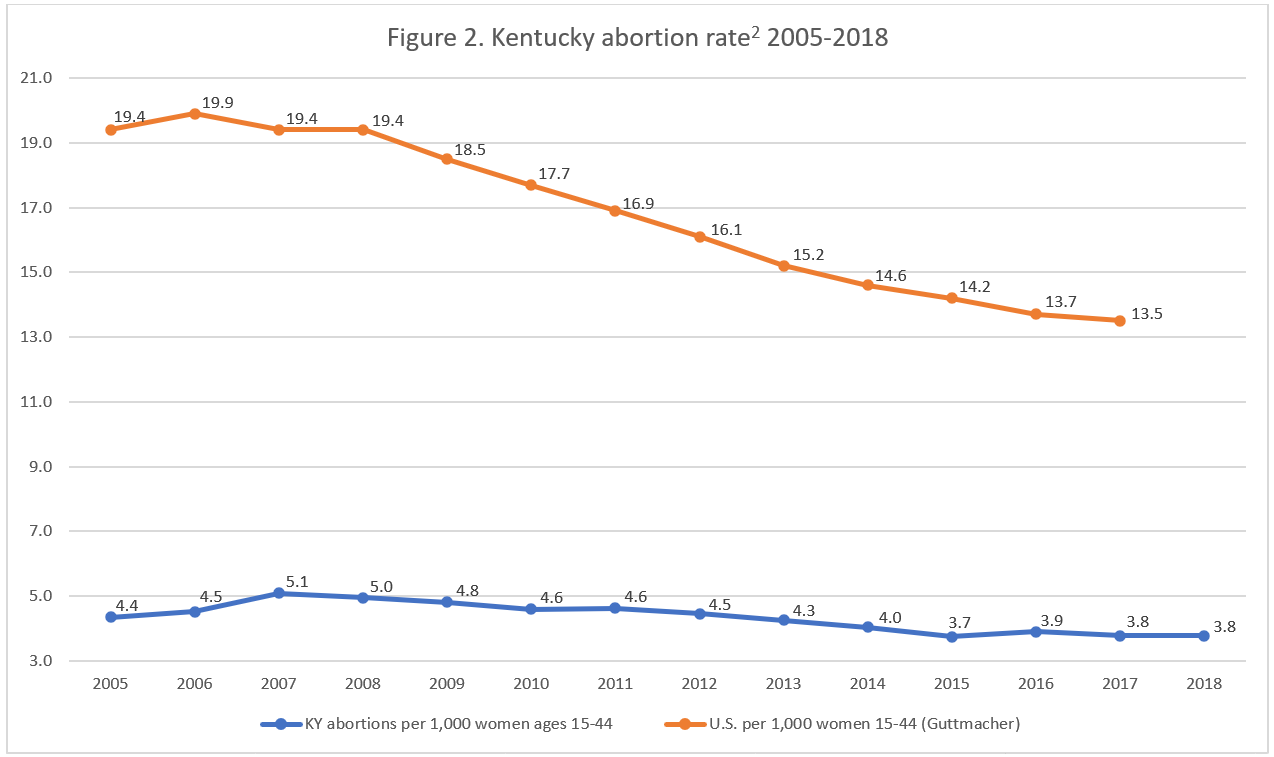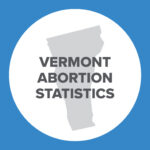Abortion Reporting: Kentucky (2018)

Kentucky’s 2018 abortion statistics were published online by the Kentucky Cabinet of Health and Family Services. Abortion totals remained steady between 2017 and 2018.
Statistics and Changes in Kentucky Abortions, 2017-2018

Abortion Totals and Trends
There were 3,203 abortions reported in Kentucky in 2018, demonstrating little change from the previous year, when 3,202 abortions occurred in the state (Fig. 1). Chemical abortions increased by three percent from 2017 to 2018. In 2018, chemical abortions composed 48 percent of the abortions reported in Kentucky. There was essentially no change in the abortion rate from 2017 to 2018, with the Charlotte Lozier Institute (CLI) estimating the rate to be 3.8 abortions per 1,000 women of childbearing age, one of the lowest abortion rates in the nation (Fig. 2).
State Report Summary
In 2018, Kentucky residents accounted for 85 percent of the abortions reported in Kentucky. An additional eight percent were performed on women from Indiana, and four percent were on women from Tennessee. The remainder were performed on women from other states and countries.
The abortions reported in Kentucky were performed on women and girls ranging in age from 12 to 45. Nine percent of the abortions reported in Kentucky were on girls under the age of 20, with three percent on girls under the age of 18 and six percent on girls ages 17 and 18. Twenty-nine percent were on women ages 20 to 24, another 29 percent were on women ages 25 to 29, and an additional 29 percent were on women ages 30 to 39. Four percent were performed on women age 40 or above.
White women made up the majority of women undergoing abortions in Kentucky (59 percent of the total). Thirty percent of the abortions were on black women, and 10 percent were on women of other races. Just one abortion was reported to have been performed on a Native American woman, and 12 abortions were performed on women whose race was not reported. CLI estimates that the white abortion rate in Kentucky was 2.5 abortions per 1,000 women ages 15 to 44, while the black abortion rate was more than four times that, at 11.5 abortions per 1,000 women ages 15 to 44. Ninety-three percent of the abortions were on non-Hispanic women. Seven percent were performed on Hispanic women, of whom half were of Mexican heritage and a third were of Cuban origin.
Eighty-five percent of the abortions reported in Kentucky were performed on single women, while 15 percent were on married women. A majority of Kentucky abortions, 62 percent, were on women who had attended college. Thirty-eight percent were on women with 12 years of education or fewer.
Sixty-two percent of the abortions were on women who had previously given birth; 26 percent were on women with one prior live birth, and 36 percent on women with two or more previous live births. More than half the abortions (58 percent) were on women with no previous induced abortions or miscarriages. Twenty-four percent were on women with one prior abortion or miscarriage and 18 percent on women with more than one.
Kentucky reports the length of pregnancies ending in abortion in two separate tables, one using gestational age and the other post-fertilization age. Gestational age dates a pregnancy from the woman’s last menstrual period, while post-fertilization age dates pregnancies from the estimated date of fertilization, approximately two weeks after the last menstrual period. In 2018, 36 percent of Kentucky abortions occurred between three to four weeks post-fertilization. Thirty-two percent were reported between five and six weeks, and 12 percent were performed from seven to eight weeks post-fertilization. Eight percent occurred from nine to 10 weeks, and five percent from 11 to 12 weeks. Three percent each occurred from 13 to 14 weeks and from 15 to 17 weeks post-fertilization. Two percent were performed at 18 and 19 weeks post-fertilization (approximately 20 and 21 weeks of gestation). Kentucky limits abortion at 20 weeks post-fertilization unless a woman is experiencing a medical emergency, and no abortions were reported at or after 20 weeks post-fertilization in 2018.
Forty-eight percent of the abortions reported in Kentucky in 2018 were chemical abortions. Forty-three percent were suction curettage procedures, and nine percent were performed using dilation and evacuation. There was one intrauterine instillation abortion. Eleven of the abortions (less than 4/10 of one percent) were reported to have been necessary to prevent the mother’s death, but the report does not provide any information on the medical basis for these abortions or the gestational ages at which they occurred.
On average, 267 abortions were performed each month in 2018. March had the highest total (366) and July had the lowest (237).
Abortion Centers in Kentucky
In 2016, Kentucky’s Cabinet for Health and Family Services sued to close EMW Women’s Clinic in Lexington for unsanitary conditions and for operating without a license. The Kentucky Supreme Court upheld a temporary injunction closing the Lexington clinic, and the abortion center officially closed in 2017 after failing to renew its lease. Also in 2016, Planned Parenthood’s Louisville center began performing abortions, but was required to halt its abortion services after the center’s license was denied because it lacked an adequate hospital transfer agreement in case of emergencies. After the closure of the Lexington center and the denial of Planned Parenthood’s license, Kentucky had a single abortion center, EMW Women’s Surgical Center in Louisville. Both EMW Women’s Surgical Center and Planned Parenthood sued the state, and the law requiring a hospital transfer agreement was struck down by the U.S. District Court for the Western District of Kentucky in 2018. The case has been appealed to the U.S Court of Appeals for the Sixth Circuit.
EMW Women’s Clinic in Lexington reported 215 abortions in 2016, and Planned Parenthood Lexington reported 17. Neither center reported any abortions in 2017 or 2018. In 2018, all the abortions reported in Kentucky were performed in Louisville. The vast majority, 99 percent, occurred at EMW Women’s Surgical Center. A few abortions were performed at Louisville hospitals, with six occurring at Norton Hospital, two at Norton Women’s and Children’s Hospital, and 10 at the University of Louisville.
However, beginning in 2020, Kentucky has two abortion centers once again. Under a new administration, Planned Parenthood was granted a license to perform abortions at its Louisville center, and that center began performing abortions in March 2020.
State Ranking
In CLI’s 2016 analysis of abortion reporting across the United States, Kentucky’s reporting was ranked at 43rd best. In the four years since then, Kentucky has taken steps to improve its reporting; in 2019, the state enacted a law to strengthen reporting for chemical abortions, and the Kentucky Cabinet for Health and Family Services now makes annual reports available online. To improve its reporting further, Kentucky could report data it collects on its informed consent process and complications resulting from abortion. This is especially important given the evidence that chemical abortions carry a significantly higher rate of complications like hemorrhaging and infection and the new pressure on the Food and Drug Administration to further weaken and abandon the Risk Evaluation and Mitigation Strategy (REMS) that governs the use of mifepristone.


- Kentucky provided CLI with reports for 2015 through 2018. Abortion totals for 2005 through 2014 were taken from the annual abortion surveillance reports published by the CDC. Kentucky first reported chemical abortion data to the CDC in 2008.
- Starting with the 2018 abortion reports, abortion rates are calculated by the CLI to allow for easier state-to-state and year-to-year comparisons. Rates were calculated by CLI using population estimates from the United States Census Bureau. The rates were calculated using the following formula: (total number of abortions performed in Kentucky ÷ number of resident women ages 15-44) x 1,000. Rates may differ slightly from previous CLI articles due to revised population estimates.
























